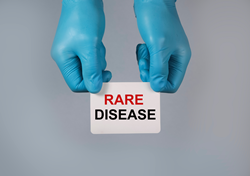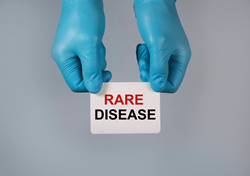
While an astounding number of patients are available for clinical trials worldwide, U.S. sponsors of potential treatments often fail to meet their target patient enrollment as they are mostly focused on the U.S. and E.U. markets during the clinical development process.
HERNDON, Va. (PRWEB)
March 20, 2023
Globally, between 263 and 446 million people are estimated to suffer from one of 11,000 named rare diseases — about half of those affected are children.(1) The term ‘rare disease’ refers to a chronic and severe disorder that affects fewer than 200,000 Americans, is poorly understood, and lacks effective treatment. Because the incidence of each disease is low within individual countries, data is extremely limited. In the U.K. and the U.S., a rare disease patient will see an average of seven physicians over the course of five to seven years before receiving a diagnosis.(2) A global rare disease patient registry is imperative to gather enough data to make an impact.(3) Dr. Harsha Rajasimha of the humanitarian non-profit IndoUSrare is forming international partnerships to develop global patient registries for each rare disease or a subset of similar rare diseases.
Dr. Rajasimha notes, “While an astounding number of patients are available for clinical trials worldwide, U.S. sponsors of potential treatments often fail to meet their target patient enrollment as they are mostly focused on the U.S. and E.U. markets during the clinical development process. This is a problem that a global patient registry could ameliorate. However, successfully creating such registries will require new strategies to motivate rare disease patients to participate.”
The problem is that most countries do not yet have patients’ health information in digital formats that are ready for consumption for the purposes of R&D. Patient registries are necessary prerequisites that are convenient and cost-effective tools for the R&D of orphan drugs.(4) They provide data on how a disease develops in different persons, the symptoms of the disease, and the effects of treatment.(5)
Dr. Rajasimha explains, “The creation & maintenance of global patient registries need to be led by qualified patient advocacy groups for rare diseases, and must overcome numerous challenges such as data protection regulations, language barriers, cultural barriers, and technical barriers. The National Institutes of Health and the FDA acknowledge that well-designed patient registries and natural history studies are critical for rare diseases as published scientific literature is limited. Patients are the scientists who have the experience living with these diseases, making them natural experts. Capturing these observations under the supervision of qualified clinical investigators can serve as a foundation for the success of future clinical trials, the evaluation of treatments, and understanding the heterogeneity in disease progression from patient to patient.”
Another challenge is the lack of a comprehensive natural history of rare diseases, which is vital to planning and guiding a study.(5) Without it, researchers and practitioners must start from scratch each time. The U.S. National Organization for Rare Disorders (NORD) advocates for registry data, stating it unites the patient and research community, helps develop treatments, and improves the quality of care.(7)
When well-documented patients from such patient registries and industry partners are ready to pursue a promising candidate orphan drug or gene therapy, much hope rests on clinical trials, the process by which regulators evaluate therapies for safety and efficacy. A stumbling block in executing clinical trials for orphan therapies is applying the same expectations from the conventional trial designs applied for common indications such as the use of placebos. Individuals with rare diseases, who have struggled for years with hard-to-diagnose and chronic symptoms, are reasonably unwilling to risk being part of a placebo group when what they desperately need is treatment. Instead, an open-label or crossover study can benefit both researchers and patients.
In an open-label study, participants know what treatment they are receiving. Sometimes a conventional double-blind clinical trial using a placebo control group can be followed by a long-term open-label study.(6) In this way, even those patients who initially receive the placebo can receive the investigational medicine.
In a crossover study, all participants receive the same two (or more) treatments. Groups are divided randomly and receive the available treatments in different sequences with a break in between. These clinical trial formats offer hope to individuals with rare diseases, increasing the number willing to participate. With such low incidences of these rare conditions, every patient is valuable.
Not all patients with rare diseases are willing to come in regularly over extended periods for observation. NORD advocates making it as easy as possible for patients so research can progress. They propose combining studies with clinical visits, synchronizing patient forms, and getting data through telehealth visits as often as possible.(7) Patient-friendly strategies and technology are essential to gathering enough information to further the research and treatment of rare diseases. In particular, decentralized trial designs and digital remote monitoring devices encourage maximum participation.
IndoUSrare currently provides free patient concierge services for rare disease patients globally on their technology platform. The IndoUSrare Corporate Alliance is committed to leveraging shared resources and developing long-term collaborations across borders for the cost-effective advancement of R&D for rare diseases. Dr. Rajasimha insists, “We cannot develop effective treatments for rare diseases without true international collaborations. The Rare Diseases communities and the Orphan Drugs Industry have been conducting research and development in small, biased populations located in the U.S. and E.U. IndoUSrare’s mission is to create bridges between geographic silos, people, cultures, and medical science to find breakthrough therapies and cures for rare diseases.” The organization invites all stakeholders of rare diseases to join their Indo-US RARE Summit on October 29-30, 2023, at the George Mason University Campus in Arlington, VA.
About IndoUSrare
IndoUSrare is a humanitarian non-profit 501(c)(3) tax-exempt public charity organization based in the U.S. Founder and Chairman Dr. Harsha Rajasimha, who lost a child to a rare disease in 2012, has been a rare disease advocate for more than 10 years. To address the unmet needs of diverse patients with rare diseases globally, the leadership team comprised of experienced professionals from research, advocacy, regulatory, and drug development seeks to build cross-border collaborations connecting stakeholders of rare diseases in low- and middle-income regions such as India, with their counterparts and clinical researchers in the U.S. to improve the diversity of clinical trial participants, accelerate research and development, and improve equitable access to life-saving therapies to diverse populations of rare disease patients. Visit https://indousrare.org.
References:
1. Millán, José M.; García-García, Gema. “Genetic Testing for Rare Diseases.” April 12, 2022, Diagnostics (Basel), ncbi.nlm.nih.gov/pmc/articles/PMC9028486/.
2. Ornskov, Flemming. “350 million people suffer from rare diseases. Here’s how tech can help.” Jan 19, 2018, World Economic Forum, weforum.org/agenda/2018/01/350-million-people-suffer-from-rare-diseases-heres-how-tech-can-help/.
3. Agency for Healthcare Research and Quality. “Registries for Evaluating Patient Outcomes: A User’s Guide: 4th Edition.” Sep 21, 2020, Effective Health Care Program, effectivehealthcare.ahrq.gov/products/registries-guide-4th-edition/users-guide.
4. Gliklich RE; Dreyer NA; Leavy MB. “Registries for Evaluating Patient Outcomes: A User’s Guide [Internet]. 3rd edition.” April 2014, Agency for Healthcare Research and Quality (US), ncbi.nlm.nih.gov/books/NBK208643/.
5. Bollerman, Cody J. “Common Problems in Clinical Trials for Rare Diseases.” May 11, 2020, Clinical Researcher, acrpnet.org/2020/05/11/common-problems-in-clinical-trials-for-rare-diseases/
6. Concert Pharmaceuticals Inc. “Understanding Clinical Trial Terminology: What Is An Open Label Clinical Trial?.” June 24th, 2019, concertpharma.com/understanding-clinical-trial-terminology-what-is-an-open-label-clinical-trial/.
7. Vita Staff. “Explainer: What Are Natural History Studies?.” March 18, 2021, CSL Behring, cslbehring.com/vita/2021/what-are-natural-history-studies

